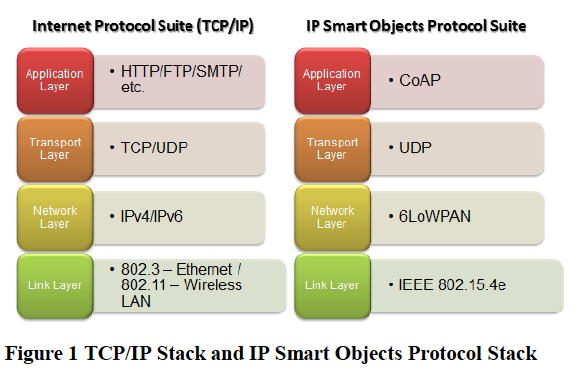Understanding IoT protocol and their usage when implementing a specific application could be a complex and discouraging task. In this post we overview existing IoT protocols & standards with the aim to better understand their features and goals. Specifically, we focus on open source IoT protocols & standards.By searching through the Internet, we found many online sources summarizing on IoT protocols and standards; for example:
- Postcapes, Tracking the Internet of Things. “Internet of Things Protocols & Standards”: http://postscapes.com/internet-of-things-protocols
- Postcapes lists web technologies, IoT software projects such as Contiki, Riot OS, etc., IoT-related organizations.
- R. Sutaria & R. Govindachari, 2013. “Making Sense of Interoperability. Protocols and Standardization Initiatives in IOT”. 2nd International Workshop on Computing and Networking for Internet of Things (CoMNet-IoT) held in conjunction with 14th International Conference on Distributed Computing and Networking (ICDCN 2013). Online: http://bit.ly/1tipZyH
- this paper presents TCP/IP stack vs. IoT major protocols. Here is the picture copied from the paper:
- Maria Rita Palattella, Nicola Accettura, Xavier Vilajosana, Thomas Watteyne, Luigi Alfredo Grieco, Gennaro Boggia and Mischa Dohler, 2012. “Standardized Protocol Stack For The Internet Of (Important) Things”, (2012). IEEE Communications Surveys and Tutorials, December 2012. Online: http://bit.ly/1zZRQKu
- The German Standardization Roadmap / Industrie 4.0 (version 1.0, issued 12.11.2014). Online: https://www.dke.de/de/std/documents/rm%20industrie%204-0_en.pdf
Our short overview of IoT protocols and standards is given below:
M2M (Machine to Machine) is considered an integral part of the IoT, with a wide range of applications such as industrial automation, logistics, Smart Grid, Smart Cities, health, etc. It is rapidly growing, and since its early days, different “standard” protocols have emerged (e.g. OMA-DM, TR-069, MQTT, …) or are emerging (e.g. CoAP or Lightweight M2M)
CoAP (Constrained Application Protocol) is a software protocol allowing simple electronics devices to communicate interactively over the Internet. It is particularly targeted for small low power sensors, switches, valves and similar components that need to be controlled or supervised remotely, through standard Internet networks (c.f. http://en.wikipedia.org/wiki/Constrained_Application_Protocol).
Lightweight M2M
TBC…

